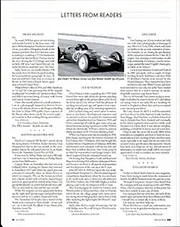
Celluloid search
Sir, Further to David Stick's letter in your magazine, I have been trying to track down the remnants of Stanley Schofield Productions for the past two years. Through Companies House…
Thierry Neuville’s huge accident during Rally Chile may have been spectacular, but it also served as a reminder of how far the World Rally Championship has progressed with its safety standards since the days of Group B.
Neuville’s Hyundai i20 Coupé WRC was pitched into a series of high-speed rolls after he clipped a ditch during the Saturday morning loop of stages on the May 10-12 event. Despite suffering a cut to his left leg and bruising to his foot, Neuville and his co-driver Nicolas Gilsoul escaped unscathed.
Gilsoul said: “I was a bit marshal and a bit doctor immediately after. We were perhaps only a few centimetres out of line and it cost us big. We were both in a state of shock afterwards and Thierry had some blood coming from his leg, so I told him to lay down and keep his helmet on while I pressed the red [emergency] button and I had to find the fire extinguisher because something was on fire at the back of the car – it was fluid on the brake disc. But the car looked after us. We’re very thankful for it.”
According to Nicky Grist, who co-drove legends such as Colin McRae and Juha Kankkunen across his 21-year WRC career, the crash illustrated the safety improvements that have been made in the sport.
“If that accident had happened in something like a Group B car, it wouldn’t have been good news,” Grist told Motor Sport. “Group B cars were hugely fast but only had thin aluminium rollcages. They were nowhere near the level of today’s cars, which protect you so much better.
“That accident was almost a best-case scenario as rolling down the road dissipates the energy and there were no trees or rocks involved. The cars are now built with a bit of flex in the chassis for times like that, because if they were rock solid the crew inside would take such a beating.
“Helmet technology now is brilliant at absorbing shock, and is up to 40 per cent stronger. Plus you have wrap-around seats that also bolt to the rollcage at the back to ensure they don’t move, because if a seat moves the belts can slacken. Plus cars must have door bars and 5-6inches of impact absorbing foam, and then there’s the frontal head restraints…
“We have the fastest World Rally Cars ever, and safety, too”
“As a competitor at world level you’re programmed to accept the risks. When I was competing at that level I honestly never thought about having a big accident, it was just get your head down and get on with the job, but we know these accidents happen. It’s good that the FIA is now involved with the safety aspect, whereas it wasn’t so much with Group B. This is why we can now have the fastest World Rally Cars ever, and still enjoy an element of safety.”
The inaugural Rally Chile was won by Toyota’s Ott Tänak, who moved to second place in the championship behind leader Sébastien Ogier.